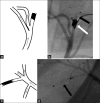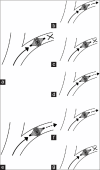Evaluation of an endovascular aneurysm model in pigs for chronic experiments
- PMID: 40224549
- PMCID: PMC11984821
- DOI: 10.4103/bc.bc_112_24
Evaluation of an endovascular aneurysm model in pigs for chronic experiments
Abstract
Background and aims: Cerebral aneurysms are a potentially life-threatening condition for humans. Due to the anatomical variability of different aneurysm types in human patients, animal models are indispensable for endovascular research. The aim of our study was to evaluate an endovascular aneurysm model in chronical experiments using 12 female Aachen minipigs.
Materials and methods: For aneurysm creation in external carotid and subclavian arteries, Amplatzer vascular plugs were used as occlusion devices, leaving simple stumps that serve as surrogate aneurysms. If necessary and anatomically possible, additional embolic materials, such as coils and liquid embolic agents were used.
Results: We created 42 aneurysms. Aneurysm creation was possible without complications in all cases. There was no spontaneous thrombosis of fabricated aneurysms. Complete perfusion arrest behind the fabricated aneurysm was challenging but achieved in 45% of cases. We were not able to identify significant factors that have an impact on the persisting perfusion of fabricated aneurysms on final imaging, particularly not the presence of side branches in the aneurysm lumen (P = 0.734) or volumes of the fabricated aneurysms (P = 0.620). Albeit not significant, the use of additional occlusive measures (coils, liquid embolic agents) and antithrombotic drugs (ASA, heparin and tirofiban) may be factors for persisting perfusion: Perfusion arrest behind the fabricated aneurysm was twice as high in animals treated with ASA and heparin compared to animals treated with ASA, heparin, and tirofiban (48% vs. 22%; P = 0.149).
Conclusion: Despite its limitations, including persistent perfusion and impaired predictability for long-term experiments, the endovascular aneurysm model shows potential to replace certain surgical models and offers broad applications in biomedical research and aneurysm therapy.
Keywords: Aachen minipig; endovascular animal model; external carotic artery; intracranial in vivo model; neuroradiology; subclavian artery.
Copyright: © 2025 Brain Circulation.
Conflict of interest statement
Martin Wiesmann has the following disclosures: Consultancy: Stryker; Payment for lectures: Bracco, Medtronic, Siemens, Stryker; Educational Presentations: Bracco, Codman, Medtronic, Phenox, Siemens; has received grants for research projects or educational exhibits from Ab medica, Acandis, Bracco Imaging, Cerenovus, Kaneka Pharmaceuticals, Medtronic, Mentice AB, Microvention, Phenox, Siemens Healthcare and Stryker Neurovascular. Omid Nikoubashman has the following disclosures: Grants: Stryker; Payment for lectures: Stryker, Phenox, and Werfen. Hani Ridwan has the following disclosures: Consultancy: ThrombX Medical Inc.
Figures



Similar articles
-
Coil embolization for intracranial aneurysms: an evidence-based analysis.Ont Health Technol Assess Ser. 2006;6(1):1-114. Epub 2006 Jan 1. Ont Health Technol Assess Ser. 2006. PMID: 23074479 Free PMC article.
-
Endovascular broad-neck aneurysm creation in a porcine model using a vascular plug.Cardiovasc Intervent Radiol. 2013 Feb;36(1):239-44. doi: 10.1007/s00270-012-0431-z. Epub 2012 Jun 27. Cardiovasc Intervent Radiol. 2013. PMID: 22735890
-
Visceral Artery Aneurysms and Pseudoaneurysms: Retrospective Analysis of Interventional Endovascular Therapy of 43 Aneurysms.Rofo. 2017 Jul;189(7):632-639. doi: 10.1055/s-0043-107239. Epub 2017 May 16. Rofo. 2017. PMID: 28511264 English.
-
Complex intracranial aneurysms: combined operative and endovascular approaches.Neurosurgery. 1998 Dec;43(6):1304-12; discussion 1312-3. doi: 10.1097/00006123-199812000-00020. Neurosurgery. 1998. PMID: 9848843 Review.
-
Endovascular management of giant intracranial aneurysms.Clin Neurosurg. 1995;42:267-93. Clin Neurosurg. 1995. PMID: 8846597 Review.
References
-
- Wardlaw JM, White PM. The detection and management of unruptured intracranial aneurysms. Brain. 2000;123(( Pt 2)(2)):205–21. - PubMed
-
- Vlak MH, Algra A, Brandenburg R, Rinkel GJ. Prevalence of unruptured intracranial aneurysms, with emphasis on sex, age, comorbidity, country, and time period: A systematic review and meta-analysis. Lancet Neurol. 2011;10:626–36. - PubMed
-
- Toth G, Cerejo R. Intracranial aneurysms: Review of current science and management. Vasc Med. 2018;23:276–88. - PubMed
LinkOut - more resources
Full Text Sources
